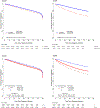Implications of missing data on reported breast cancer mortality
- PMID: 36334190
- PMCID: PMC9912364
- DOI: 10.1007/s10549-022-06764-4
Implications of missing data on reported breast cancer mortality
Abstract
Background: National cancer registries are valuable tools to analyze patterns of care and clinical outcomes; yet, missing data may impact the accuracy and generalizability of these data. We sought to evaluate the association between missing data and overall survival (OS).
Methods: Using the NCDB (National Cancer Database) and SEER (Surveillance, Epidemiology, End Results Program), we assessed data missingness among patients diagnosed with invasive breast cancer from 2010 to 2014. Key variables included demographic (age, race, ethnicity, insurance, education, income), tumor (grade, ER, PR, HER2, TNM stages), and treatment (surgery in both databases; chemotherapy and radiation in NCDB). OS was compared between those with and without missing data using Cox proportional hazards models.
Results: Overall, 775,996 patients in the NCDB and 263,016 in SEER were identified; missing at least 1 key variable occurred for 29% and 13%, respectively. Of those, the overwhelming majority (NCDB 80%; SEER 88%) were missing tumor variables. When compared to patients with complete data, missingness was associated with a greater risk of death: NCDB HR 1.23 (99% CI 1.21-1.25) and SEER HR 2.11 (99% CI 2.05-2.18). Patients with complete tumor data had higher unadjusted OS estimates than that of the entire sample: NCDB 82.7% vs 81.8% and SEER 83.5% vs 81.7% for 5-year OS.
Conclusions: Missingness of select variables is not uncommon within large national cancer registries and is associated with a worse OS. Exclusion of patients with missing variables may introduce unintended bias into analyses and result in findings that underestimate breast cancer mortality.
Keywords: Breast cancer; Cancer registry; Data missingness; Databases; Outcomes; Survival.
© 2022. The Author(s), under exclusive licence to Springer Science+Business Media, LLC, part of Springer Nature.
Figures





References
-
- Janz TA, Graboyes EM, Nguyen SA, Ellis MA, Neskey DM, Harruff EE, Lentsch EJ: A Comparison of the NCDB and SEER Database for Research Involving Head and Neck Cancer. Otolaryngol Head Neck Surg 2019, 160(2):284–294. - PubMed
-
- Mallin K, Browner A, Palis B, Gay G, McCabe R, Nogueira L, Yabroff R, Shulman L, Facktor M, Winchester DP et al. : Incident Cases Captured in the National Cancer Database Compared with Those in U.S. Population Based Central Cancer Registries in 2012–2014. Ann Surg Oncol 2019. - PubMed
-
- Newman DA: Missing Data:Five Practical Guidelines. Organizational Research Methods 2014, 17(4):372–411.
MeSH terms
Grants and funding
LinkOut - more resources
Full Text Sources
Medical
Research Materials
Miscellaneous

